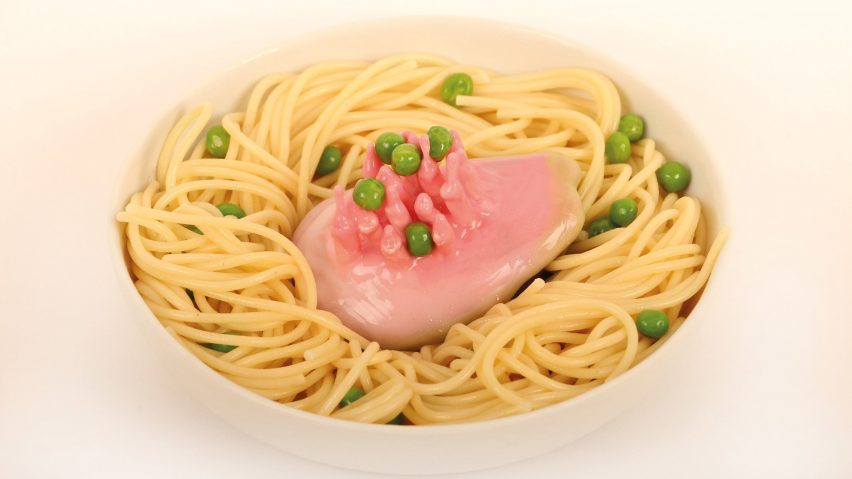Continuing our review of 2017, design editor Alice Morby reflects on the year's trends, which include a rise in political responses, eco-friendly solutions, and a focus on food consumption.
Food was at the forefront
Food continued to be a popular topic explored by designers this year, with many exploring alternatives to current consumption methods and ingredients.
Marije Vogelzang, who has pioneered the area since her time as a student, extended her research with a series of objects designed to prevent diners from overeating. During Milan design week, a group of graduates from ÉCAL devised methods for sustainable meat consumption with the intention of sparking discussion around the overconsumption of meat and the strain that it puts on the planet's resources.
Designers got political
This year saw designers using their skills to respond to a turbulent political climate, from peace-promoting proposals for Donald Trump's Mexico border wall to postcards designed for a post-Brexit Britain.
The Designs of the Year nominations were particularly reflective of this, and many of the nominations had more of a political focus – such as a pink "pussyhat" with cat-shaped ears, which became a symbol of the Women's March on Washington following Trump's inauguration, as well as Wolfgang Tillmans' Remain Campaign for the Brexit referendum.
Big companies revealed a conscience
IKEA, Adidas and Stella McCartney were among the big design companies attempting to get with the times, and adopt eco-friendly alternatives for their process and material choices in 2017.
Ocean plastic became a major part of Adidas' agenda over the past year, with the brand releasing a number of items made from repurposed waste washed up on shores and beaches.
Periods became prevalent
Areas of women's health that were previously neglected by designers came to attention throughout the past year, and unsurprisingly – it was graduate designers who were at the forefront.
Aiming to change our attitudes towards menstruation, Central Saint Martins graduate Kaye Toland developed a tampon delivery system that transforms sanitary products into compost, while Ailsa Inglis designed a menstrual cup aimed specifically at young girls, with the aim of normalising alternative period products.
Apple met its match
In the year that saw Apple make the "the biggest leap forward since the original iPhone" with its iPhone X, other tech companies also made big advances and leaps in hopes of reclaiming the industry top-spot.
BlackBerry unveiled its Motion smartphone, which ditches the brand's trademark QWERTY keyboard in favour of a touchscreen interface, while a patent revealed Facebook is working on a Project Ara-style modular smartphone.
Tickled-millenial pink
So-called millenial pink was seen everywhere this year, making everything from architectural facades to installations Instagram-friendly.
The shade, which is somewhere between beige and blush, dominated Milan design week, where it was showcased by popular brands including Moroso, Muuto and Normann Copenhagen, and featured on the event's most Instagrammed installation – Marc Ange's Le Refuge.
IKEA-mania hit
Dezeen readers couldn't get enough of IKEA in 2017. In the space of just 12 months, the company launched its first range of furniture for cats and dogs, created solar battery packs to rival Tesla's Powerwall, revealed its collaborative collection with Hay and ventured into smart home products with a new lighting series.
But it also embarked on some big initiatives, announcing it was to employ refugees at production centres in Jordan over summer as part of a long-term plan to create employment for 200,000 disadvantaged people around the world.
Product launches lessened
With the exception of IKEA's huge offering, 2017 felt like a relatively quiet year in terms of furniture and homeware launches. It was instead installations that dominated design weeks.
Perhaps it's a sign of the times, as in 2017 our audience preferred to read about driverless cars, artificial intelligence, robots, new materials, virtual and augmented reality, Brexit, Trump, refugees and climate change.
Racing towards a robotic future
Robots for all sorts of uses have been unveiled in the past 12 months, but 2017 will go down in history as the year that in which an AI device was actually granted citizenship.
But many in the design industry expressed concerns about the way humans and robots will live together. In an opinion piece written for Dezeen this year designer Madeline Gannon suggested that the rapid growth of robotics in global manufacturing could place people's livelihoods at risk, and called for designers and architects to play a role in shaping how the technology is used.
Materials got weirder
Mushrooms, bovine guts and old televisions were among some of the waste materials transformed into new products by designers this year.
During London Design Festival, Sebastian Cox and Ninela Ivanova presented a series of suede-like furniture made from mushroom mycelium, while a Design Academy Eindhoven graduate repurposed discarded cow stomachs to create textured leather-like handbags.

